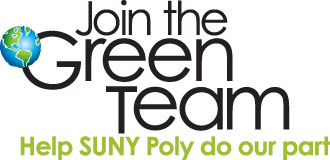 SUNY Poly recognizes its role and commitment in helping create a sustainable campus community and world. The campus community will lead by example and through actions grounded in theory and practice. SUNY Poly will become an environmentally conscious campus that organizes itself around the following themes: academic integration, campus awareness, recycling, and energy conservation.
SUNY Poly recognizes its role and commitment in helping create a sustainable campus community and world. The campus community will lead by example and through actions grounded in theory and practice. SUNY Poly will become an environmentally conscious campus that organizes itself around the following themes: academic integration, campus awareness, recycling, and energy conservation.
In the fall of 2011, a class project for an undergraduate Environmental Sustainability course yielded SUNY Poly's first-ever comprehensive greenhouse gas emissions inventory. The inventory report, covering emissions from 2001 - 2010, and projections to 2020, was presented to SUNY Poly's President, Chief Operations Officer, and Director of Facilities at a joint meeting. Beyond measuring our carbon footprint, the inventory was the first step toward creating a Climate Action Plan to reduce emissions in the future and enabling signature of the Climate Leadership Commitment."
In 2014, SUNY Poly received a Certificate of Honor for Environmental Stewardship from the U.S. Green Building Council New York Upstate Chapter.
SUNY Poly Greenhouse Gas Emissions Inventory on Prezi
LEED Requirements
SUNY Poly's new buildings meet specific LEED (Leadership in Energy and Environmental Design) requirements. LEED is an internationally recognized green building certification system, providing third-party verification that a building was designed and built using strategies aimed at improving performance across these metrics: energy savings, water efficiency, CO2 emissions reduction, improved indoor environmental quality, and stewardship of resources and sensitivity to their impacts.
Developed by the U.S. Green Building Council (USGBC), LEED provides building owners and operators a framework for identifying and implementing practical and measurable green building design, construction, operations and maintenance solutions.
Find out more about how each new building meets LEED requirements.

